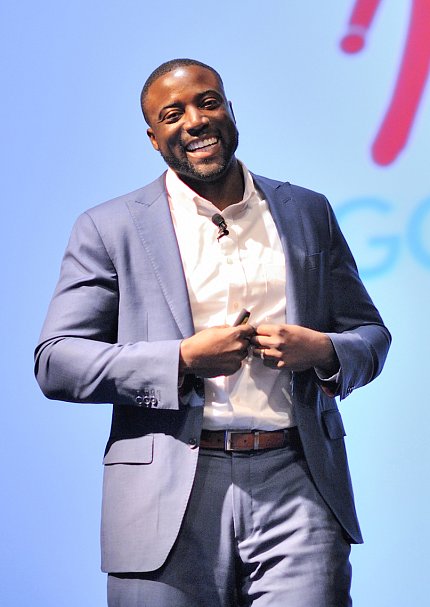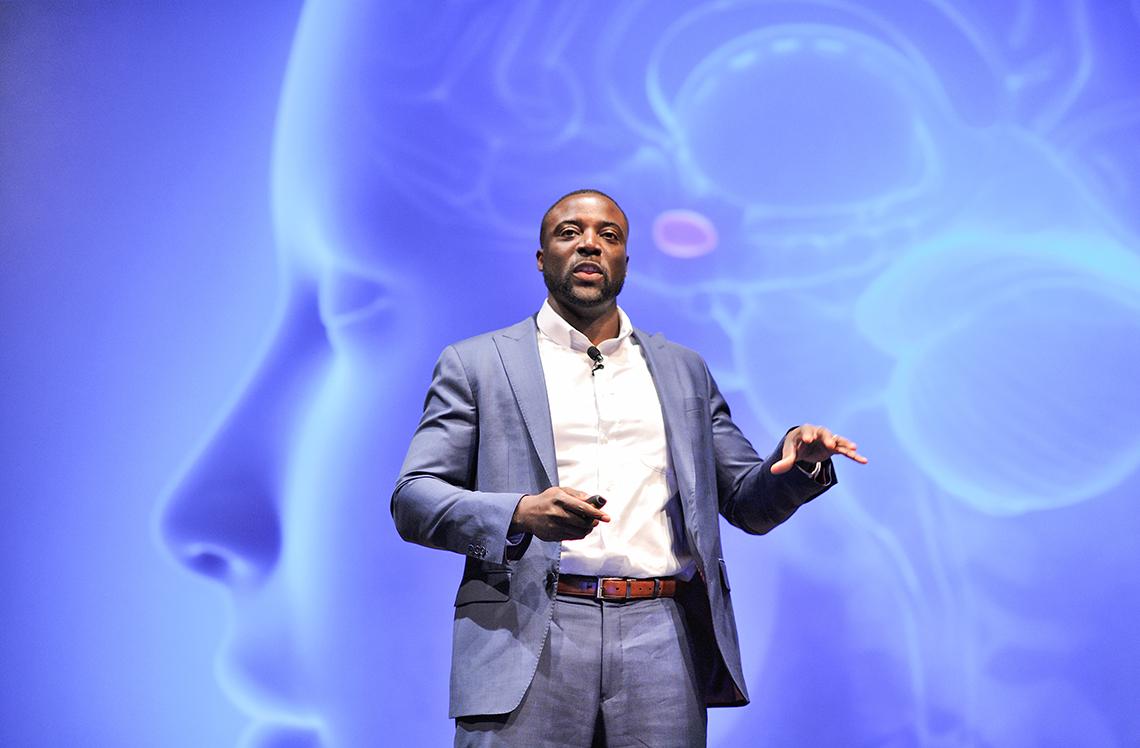Dare I Ask?
Negotiator Discusses How to Navigate Conflict

Photo: Marleen Van Den Neste
The very thought of confrontation often makes our flight response kick in. We tend to dread or outright avoid potentially difficult conversations. The reality, though, is that they’re inescapable. Conflict is everywhere. Luckily, there’s a skill to negotiating well and it starts with looking at conflict not as a threat, but as an opportunity.
Approach any negotiation with the belief that it’s a skill we can learn and improve upon, said Kwame Christian, a lawyer and director of the American Negotiation Institute. His recent lecture in Masur Auditorium launched a new season of Deputy Director for Management seminars, organized by the NIH Training Center.
“We want to look at conflict as a signal of something that might be problematic in the underlying relationship, so we want to move toward it,” with the goal of learning from and sharing with each other, said Christian, “to co-create a future that’s acceptable.”
Christian came prepared to address an NIH audience, armed with the basic science behind difficult conversations as well as practical tools to improve our skills.
Engaging in difficult conversations, he explained, is often a tug of war between two parts of the brain: the amygdala, responsible for emotions, and the prefrontal cortex, which regulates emotions and controls executive function and reasoning.
We have a biological response to emotional threat: our heart rate quickens, we start breathing faster. Then we start talking faster. If we’re in a conversation where emotions are running high, we can’t think clearly and neither person is really listening to the other’s points.
In children, the prefrontal cortex isn’t yet developed to regulate emotion. That’s why it’s futile trying to reason with a toddler having a tantrum, said Christian, who keeps learning lessons from his toddler son. “A lot of times, when we think we’re having a high-level conversation [with an adult], we’re really talking to their inner toddler, and that’s not productive.” Instead, we want the prefrontal cortex in control of the conversation.
Now a veteran mediator, Christian admitted he used to avoid confrontation throughout his childhood. He recounted having trouble making friends as a young child in small-town Ohio, encumbered by a thick Caribbean accent. Determined not to feel lonely, he set out to make lots of friends and then didn’t want to jeopardize his newfound popularity by engaging in difficult conversations.

Photo: Marleen Van Den Neste
“We’re all unique, so we’re all going to have different experiences that shape the way we interact with people,” said Christian. “There’s something we can look back on and see predictable gaps in performance; there’s a gap between where we are currently and where we want to be.”
Reflect on your barriers and create strategies to overcome them, he advised. But don’t get so introspective that it gets in the way of embarking on meaningful conversations.
In college, a life-changing conversation would send Christian on his future career path. A mentor told him there’s a difference between being liked and being respected. To succeed, he’d told Christian, find confidence in conflict.
“As you start engaging in conflict intentionally,” said Christian, “you are getting better every time and, as you practice more, you’re going to become more confident and more likely to do it.”
The simple framework that Christian espouses is based on compassionate curiosity.
First, acknowledge the other person’s emotions at the beginning and throughout the conversation. “You have a right to be upset” or “I can see why you’d feel frustrated...”
With this strategy, “we’re quieting the amygdala so we can speak to the prefrontal cortex,” explained Christian. “Emotions will be a legitimate barrier in these difficult conversations. Acknowledge that; get it out of the way, so you can move on to the substance later.”
Next, gather information by asking open-ended questions, which allows the other person to elaborate.
“Information is the lifeblood of difficult conversations, whether it’s a negotiation or a conflict,” said Christian. “The more information you get, the better. But you want to make sure your tone is correct.”
Asking questions with compassionate curiosity helps the other person feel safer to share the answers, said Christian. The trick is to do more listening than talking.
Keep asking questions. This keeps the person thinking and, by using the prefrontal cortex, remaining in a productive mindset. Start broadly, then get more specific, so you’re gauging what’s important to the person while guiding the discussion toward getting the relevant information.
Next comes the brainstorming. This is the time to restate goals and stay focused on them. Continue acknowledging emotion and asking more questions. Create a positive storyline.
Look at conflict as an opportunity to further the mission of NIH, said Christian. “If you engage in conflict in a meaningful way, you increase understanding and improve the relationship,” he said. “Then your work product becomes better because that conflict simmering below the surface is no longer a distraction.”
Becoming proficient at negotiating takes commitment and practice, he concluded.
“There are going to be situations where it doesn’t work, where you follow everything perfectly and you don’t get what you want,” said Christian. “That’s why giving yourself the license to fail in these conversations is important. You still want to have that interaction…you do it because the relationship is worth it and because every time you do it, you keep getting better.”
